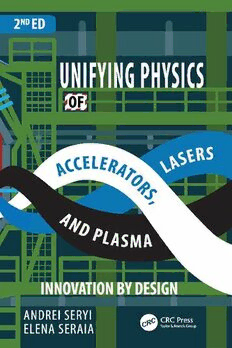
Unifying Physics of Accelerators Lasers and Plasma PDF
Preview Unifying Physics of Accelerators Lasers and Plasma
Unifying Physics of Accelerators, Lasers and Plasma Unifying Physics of Accelerators, Lasers and Plasma introduces the physics of accelerators, lasers and plasma in tandem with the industrial methodology of inventiveness, a technique that teaches that similar problems and solutions ap- pear again and again in seemingly dissimilar disciplines. This unique approach builds bridges and enhances connections between the three aforementioned ar- eas of physics that are essential for developing the next generation of accelerators. A Breakthrough by Design approach, introduced in the book as an amalgam of TRIZ inventive principles and laws of technical system evolution with the art of back-of-the-envelope estimations, via numerous examples and exercises dis- cussed in the solution manual, will make you destined to invent. Unifying Physics of Accelerators, Lasers and Plasma outlines a path from idea to practical implementation of scientific and technological innovation. This sec- ond edition has been updated throughout, with new content on superconducting technology, energy recovery, polarization, various topics of advanced technology, etc., making it relevant for the Electron-Ion Collider project, as well as for ad- vanced lights sources, including Free Electron Lasers with energy recovery. The book is suitable for students at the senior undergraduate and graduate levels, as well as for scientists and engineers interested in enhancing their abilities to work successfully on the development of the next generation of facilities, devices and scientific instruments manufactured from the synergy of accelerators, lasers and plasma. Solutions manual is included into the book Features • Introduces the physics of accelerators, lasers, and plasma in tandem with the industrial methodology of inventiveness • Outlines a path from idea to practical implementation of scientific and tech- nological innovation • Contains more than 380 illustrations and numerous end-of-chapter exercises Unifying Physics of Accelerators, Lasers and Plasma Second Edition Andrei A. Seryi Elena I. Seraia Designed cover image: Alexandra Seraia Second edition published 2023 by CRC Press 6000 Broken Sound Parkway NW, Suite 300, Boca Raton, FL 33487-2742 and by CRC Press 4 Park Square, Milton Park, Abingdon, Oxon, OX14 4RN CRC Press is an imprint of Taylor & Francis Group, LLC © 2023 Andrei A. Seryi and Elena I. Seraia First edition published by CRC Press 2016 Reasonable efforts have been made to publish reliable data and information, but the author and pub- lisher cannot assume responsibility for the validity of all materials or the consequences of their use. The authors and publishers have attempted to trace the copyright holders of all material reproduced in this publication and apologize to copyright holders if permission to publish in this form has not been obtained. If any copyright material has not been acknowledged please write and let us know so we may rectify in any future reprint. Except as permitted under U.S. Copyright Law, no part of this book may be reprinted, reproduced, transmitted, or utilized in any form by any electronic, mechanical, or other means, now known or hereafter invented, including photocopying, microfilming, and recording, or in any information stor- age or retrieval system, without written permission from the publishers. For permission to photocopy or use material electronically from this work, access www.copyright.com or contact the Copyright Clearance Center, Inc. (CCC), 222 Rosewood Drive, Danvers, MA 01923, 978-750-8400. For works that are not available on CCC please contact mpkbook- [email protected] Trademark notice: Product or corporate names may be trademarks or registered trademarks and are used only for identification and explanation without intent to infringe. ISBN: 978-1-032-35035-6 (hbk) ISBN: 978-1-032-35250-3 (pbk) ISBN: 978-1-003-32607-6 (ebk) DOI: 10.1201/9781003326076 Typeset in Nimbus Roman by KnowledgeWorks Global Ltd. Publisher’s note: This book has been prepared from camera-ready copy provided by the authors. Dedication to Our Teachers – Inventors, Scientists and Relativistic Engineers Contents ListofFigures.......................................................................................................xvii ListofTables........................................................................................................xxix Forewordtothesecondedition..........................................................................xxxi Forewordtofirstedition...................................................................................xxxiii Prefacetothesecondedition.............................................................................xxxv Prefacetofirstedition......................................................................................xxxvii Authors...............................................................................................................xxxix Chapter1 BasicsofAcceleratorsandoftheArtofInventiveness ..................1 1.1 Acceleratorsandsociety.......................................................1 1.2 Accelerationofwhatandhow..............................................3 1.2.1 Uses,actionsandtheevolutionofaccelerators.......3 1.2.2 Livingstonplotandcompetitionoftechnologies.....6 1.3 Acceleratorsandinventions..................................................7 1.4 Howtoinvent......................................................................10 1.4.1 Howtoinvent—evolutionofthemethods...........10 1.5 TRIZmethod......................................................................12 1.5.1 TRIZinaction—examples...................................13 1.6 TRIZmethodforscience....................................................15 1.7 AS-TRIZ.............................................................................16 1.8 TRIZandcreativity.............................................................20 1.9 Theartofscientificpredictions..........................................21 1.10 Theartofestimations.........................................................24 1.11 Breakthroughbydesignapproach......................................26 Chapter2 TransverseDynamics.....................................................................29 2.1 Maxwellequationsandunits .............................................29 2.2 Simplestaccelerator............................................................31 2.3 Equationsofmotion............................................................32 2.3.1 MotionofchargedparticlesinEMfields..............32 vii viii Contents 2.3.2 DriftincrossedE×Bfields..................................33 2.3.3 Motioninquadrupolefields...................................34 2.3.4 Linearbetatronequationsofmotion......................35 2.4 Matrixformalism................................................................37 2.4.1 Pseudo-harmonicoscillations................................37 2.4.2 Principaltrajectories..............................................38 2.4.3 Examplesoftransfermatrices................................40 2.4.4 Matrixformalismfortransferlines........................41 2.4.5 Analogywithgeometricoptics..............................41 2.4.6 AnexampleofaFODOlattice..............................43 2.4.7 Twissfunctionsandmatrixformalism...................44 2.4.8 Stabilityofbetatronmotion...................................44 2.4.9 StabilityofaFODOlattice....................................45 2.4.10 Propagationofopticsfunctions.............................46 2.5 Phasespace.........................................................................46 2.5.1 PhasespaceellipseandCourant–Snyder invariant..................................................................46 2.6 Dispersionandtunes...........................................................47 2.6.1 Dispersion..............................................................47 2.6.2 Betatrontunesandresonances...............................49 2.7 Aberrationsandcoupling....................................................50 2.7.1 Chromaticity..........................................................50 2.7.2 Coupling.................................................................51 2.7.3 Higherorders.........................................................51 2.8 TailFoldingOctupoles—InventionCaseStudy...............53 Chapter3 SynchrotronRadiation ..................................................................57 3.1 SRonthebackofanenvelope............................................57 3.1.1 SRpowerloss .......................................................57 3.1.2 Coolingtime..........................................................59 3.1.3 Coolingtimeandpartition.....................................60 3.1.4 SRphotonenergy...................................................60 3.1.5 SR—numberofphotons......................................61 3.2 SReffectsonthebeam.......................................................62 3.2.1 SR-inducedenergyspread.....................................62 3.2.2 SR-inducedemittancegrowth................................63 3.2.3 Equilibriumemittance............................................64 3.3 SRfeatures..........................................................................64 3.3.1 Emittanceofsingleradiatedphoton......................65 3.3.2 SRspectrum...........................................................66 3.3.3 Brightnessorbrilliance..........................................66 3.3.4 Ultimatebrightness................................................67 3.3.5 Wigglerandundulatorradiation............................68 3.3.6 SRquantumregime................................................68 3.4 LEPEnergyIncrease—InventionCaseStudy..................69 Contents ix Chapter4 SynergiesbetweenAccelerators,LasersandPlasma....................73 4.1 Create..................................................................................73 4.1.1 Beamsources.........................................................75 4.1.2 Lasers.....................................................................77 4.1.3 Plasmageneration..................................................79 4.2 Energize..............................................................................80 4.2.1 Beamacceleration..................................................81 4.2.2 Laseramplifiers......................................................81 4.2.3 Laserrepetitionrateandefficiency .......................82 4.2.4 Fiberlasersandslablasers....................................83 4.2.5 CPA—chirpedpulseamplification.......................84 4.2.6 OPCPA—opticalparametricCPA........................85 4.2.7 Plasmaoscillations.................................................85 4.2.8 Criticaldensityandsurface....................................87 4.3 Manipulate..........................................................................88 4.3.1 Beamandlaserfocusing........................................88 4.3.2 Weakandstrongfocusing......................................88 4.3.3 Aberrationsforlightandbeam..............................89 4.3.4 Compressionofbeamandlaserpulses..................92 4.4 Interact................................................................................93 4.5 CreationofMakTelescope—InventionCaseStudy.........94 Chapter5 ConventionalAcceleration............................................................97 5.1 Historicalintroduction........................................................97 5.1.1 Electrostaticaccelerators.......................................98 5.1.2 Synchrotronsandlinacs.........................................99 5.1.3 Widero¨elinearaccelerator...................................100 5.1.4 Alvarezdrifttubelinac........................................101 5.1.5 Phasefocusing.....................................................102 5.1.6 Synchrotronoscillations.......................................103 5.2 Waveguides.......................................................................104 5.2.1 Wavesinfreespace..............................................104 5.2.2 Conductingsurfaces.............................................105 5.2.3 Groupvelocity.....................................................105 5.2.4 Dispersiondiagramforawaveguide....................107 5.2.5 Iris-loadedstructures............................................108 5.3 Cavities.............................................................................109 5.3.1 Wavesinresonantcavities...................................110 5.3.2 Pill-boxcavity......................................................110 5.3.3 Qualityfactorofaresonator................................111 5.3.4 Shuntimpedance—R ........................................112 s 5.3.5 Energygainandtransit-timefactor......................112 5.3.6 Kilpatricklimit.....................................................113 5.4 Longitudinaldynamics.....................................................114
